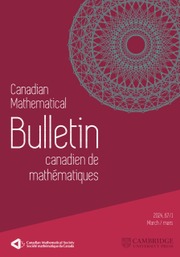Article contents
The Metric Dimension of Circulant Graphs
Published online by Cambridge University Press: 20 November 2018
Abstract
Abstract. A subset  $W$ of the vertex set of a graph
$W$ of the vertex set of a graph  $G$ is called a resolving set of
$G$ is called a resolving set of  $G$ if for every pair of distinct vertices
$G$ if for every pair of distinct vertices  $u,\,v$ , of
$u,\,v$ , of  $G$ , there is
$G$ , there is  $w\,\in \,W$ such that the distance of
$w\,\in \,W$ such that the distance of  $w$ and
$w$ and  $u$ is different from the distance of
$u$ is different from the distance of  $w$ and
$w$ and  $v$ . The cardinality of a smallest resolving set is called the metric dimension of
$v$ . The cardinality of a smallest resolving set is called the metric dimension of  $G$ , denoted by
$G$ , denoted by  $\dim\left( G \right)$ . The circulant graph
$\dim\left( G \right)$ . The circulant graph  ${{C}_{n}}\left( 1,\,2,\,.\,.\,.\,,\,t \right)$ consists of the vertices
${{C}_{n}}\left( 1,\,2,\,.\,.\,.\,,\,t \right)$ consists of the vertices  ${{v}_{0}},\,{{v}_{1\,}},\,.\,.\,.\,,{{v}_{n\,-\,1}}$ and the edges
${{v}_{0}},\,{{v}_{1\,}},\,.\,.\,.\,,{{v}_{n\,-\,1}}$ and the edges  ${{v}_{i}}{{v}_{i\,+\,j}}$ , where
${{v}_{i}}{{v}_{i\,+\,j}}$ , where  $0\,\le \,i\,\le \,n\,-\,1,1\,\le \,j\,\le \,t\,\left( 2\,\le \,t\,\le \,\left\lfloor \frac{n}{2} \right\rfloor\right)$ , the indices are taken modulo
$0\,\le \,i\,\le \,n\,-\,1,1\,\le \,j\,\le \,t\,\left( 2\,\le \,t\,\le \,\left\lfloor \frac{n}{2} \right\rfloor\right)$ , the indices are taken modulo  $n$ . Grigorious, Manuel, Miller, Rajan, and Stephen proved that
$n$ . Grigorious, Manuel, Miller, Rajan, and Stephen proved that  $\dim\left( {{C}_{n}}\left( 1,\,2,\,.\,.\,.\,,\,t \right) \right)\,\ge \,t\,+\,1$ for
$\dim\left( {{C}_{n}}\left( 1,\,2,\,.\,.\,.\,,\,t \right) \right)\,\ge \,t\,+\,1$ for  $t\,<\,\left\lfloor \frac{n}{2} \right\rfloor ,\,n\,\ge \,3$ , and they presented a conjecture saying that
$t\,<\,\left\lfloor \frac{n}{2} \right\rfloor ,\,n\,\ge \,3$ , and they presented a conjecture saying that  $\dim\left( {{C}_{n}}\left( 1,\,2,\,.\,.\,.\,,\,t \right) \right)\,=\,t\,+\,p\,-\,1$ for
$\dim\left( {{C}_{n}}\left( 1,\,2,\,.\,.\,.\,,\,t \right) \right)\,=\,t\,+\,p\,-\,1$ for  $n\,=\,2tk\,+\,t\,+\,p$ , where
$n\,=\,2tk\,+\,t\,+\,p$ , where  $3\,\le \,p\,\le \,t\,+\,1$ . We disprove both statements. We show that if
$3\,\le \,p\,\le \,t\,+\,1$ . We disprove both statements. We show that if  $t\,\ge \,4$ is even, there exists an infinite set of values of
$t\,\ge \,4$ is even, there exists an infinite set of values of  $n$ such that
$n$ such that  $\dim\left( {{C}_{n}}\left( 1,\,2,\,.\,.\,.\,,t \right) \right)\,=\,t$ . We also prove that
$\dim\left( {{C}_{n}}\left( 1,\,2,\,.\,.\,.\,,t \right) \right)\,=\,t$ . We also prove that  $\dim\left( {{C}_{n}}\left( 1,\,2,\,.\,.\,.\,,\,t \right) \right)\,\le \,t\,+\,\frac{p}{2}$ for
$\dim\left( {{C}_{n}}\left( 1,\,2,\,.\,.\,.\,,\,t \right) \right)\,\le \,t\,+\,\frac{p}{2}$ for  $n\,=\,2tk\,+\,t\,+\,p$ , where
$n\,=\,2tk\,+\,t\,+\,p$ , where  $t$ and
$t$ and  $p$ are even,
$p$ are even,  $t\,\ge \,4,\,2\,\le \,p\,\le \,t$ , and
$t\,\ge \,4,\,2\,\le \,p\,\le \,t$ , and  $k\,\ge \,1$ .
$k\,\ge \,1$ .
Information
- Type
- Research Article
- Information
- Copyright
- Copyright © Canadian Mathematical Society 2017
References
- 13
- Cited by

